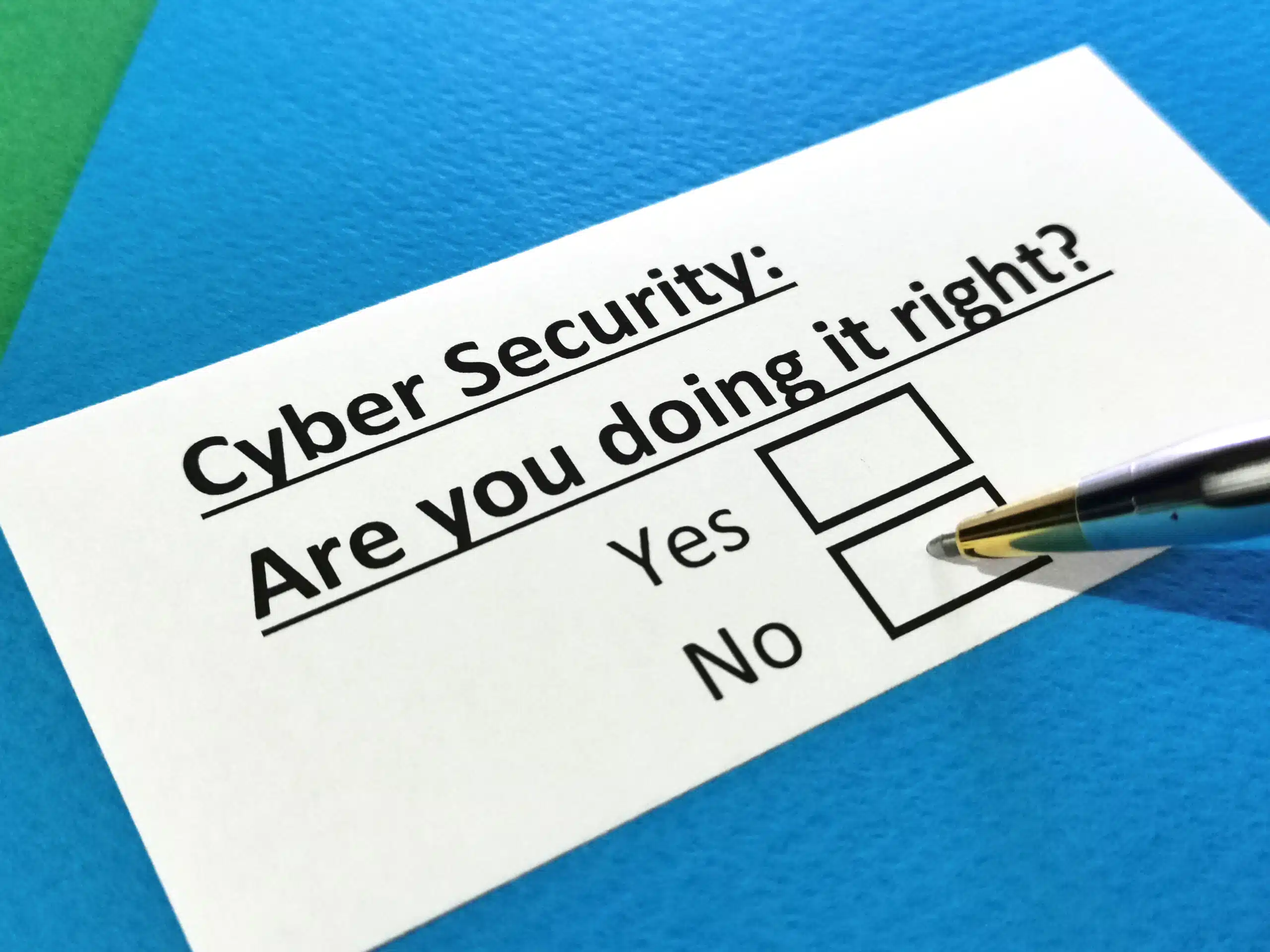In 2021, despite many technological advances, cybersecurity issues pose increasing threats to businesses. The COVID-19 pandemic brought on a surge as more people began working remotely. And its subsequent financial recession has inhibited companies’ ability to establish and manage satisfactory cybersecurity practices. As a result, many organizations’ data remains unprotected, making them vulnerable to cyberattacks and data breaches.
These risks alone demand cybersecurity awareness training programs for employees. Explore why these programs are critical in today’s workplace—at the office and home office. Then, learn seven must-implement ways to increase the effectiveness of your program among your employees.
The culprit: Human error
According to a recent study from Stanford University, when it comes to cybersecurity, the most significant threat is human error. This study found employee mistakes as the root of 88 percent of data breach incidents. It identified younger employees, over older employees, as more likely to fall prey to phishing attempts and admit to errors.
 An IBM study that encapsulated thousands of their customers in over 130 countries revealed that human error significantly contributed to 95 percent of all breaches. Namely, in the absence of human error, 19 out of 20 breaches analyzed in this study would have been avoided completely. These findings show that even the most sophisticated of technical security measures cannot remain stronger or more resilient than the human who applies them. Understanding human error’s significant role in cyber breaches is the first step toward protecting your organization against potential threats. To successfully mitigate risk in 2021, a proactive approach is of the essence.
An IBM study that encapsulated thousands of their customers in over 130 countries revealed that human error significantly contributed to 95 percent of all breaches. Namely, in the absence of human error, 19 out of 20 breaches analyzed in this study would have been avoided completely. These findings show that even the most sophisticated of technical security measures cannot remain stronger or more resilient than the human who applies them. Understanding human error’s significant role in cyber breaches is the first step toward protecting your organization against potential threats. To successfully mitigate risk in 2021, a proactive approach is of the essence.
7 Essential steps to cyber security awareness training
#1. Ongoing employee cybersecurity education
The more you make your employees aware of cybersecurity risks and how to overcome them, the more likely they are to succeed at protecting your organization and assets against phishing, malware, and other threats. Investing in your employees’ cyber literacy also makes them more aware of the importance of their job, motivating them to perform better and remain on board in the long term.
Awareness alone isn’t a lofty enough goal for cyber security awareness training. Rather, to change those security-related behaviors that result in attacks and loss, top-performing cybersecurity awareness training programs present various scenarios that help employees internalize what they must remain aware of and why. These programs aren’t on a “one-and-done” basis. Instead, they’re held repeatedly, while continuously integrating new and relevant knowledge and insights.
#2. A hands-on learning approach
With cybersecurity awareness, the theory you teach your employees is effective only when they put it into practice. To successfully prevent attacks, such as phishing emails, your cybersecurity awareness employee training program must include more than mere training. Alone, training ensures only the input of educational materials.
Instead, translate the knowledge you want your program to impart to your employees into learning. Putting that knowledge into practice ensures employees properly apply it and adhere to those lessons. This hands-on approach integrates procedural learning and highly relevant, contextual, and immediate feedback (see tip #4). This way, all parties involved understanding the mastery of the subject, while forming memories that change habits and eliminate errors on the spot.
#3. Targeted persona groups by risk
Some employees are at greater risk than others of opening doors to cyberattacks. In fact, less than 20 percent of employees in an organization are statistically responsible for most human error-induced loss.
To identify those high-risk employees, run simulations multiple times a year. Then, leverage a precise formula and algorithm that can measure risk in an effective way. By having a better grasp of the various microsegments within your employee base, you’ll find it easier and more effective to develop and implement highly targeted interventions for each segment according to their risk level.
 With micro-segmentation, you gain a clearer picture of the various risk group personas in your organization. They give you insights, so you can:
With micro-segmentation, you gain a clearer picture of the various risk group personas in your organization. They give you insights, so you can:
- Better understand the various levels of risk that different employees “invite” into the organization.
- Identify more precise courses of action, according to each group of employees and their associated risks.
- Engage in more economical monitoring by supervising groups, rather than individuals, while protecting the privacy of individual employees on the job.
#4. Predictive analytics
Predictive insider-persona analytics take your targeted persona groups to the next level. With analytics, you can identify and actively monitor high-risk personas according to specific markers. In doing so, you can better understand which groups or individuals are more likely to represent threats before they emerge and then take action to prevent them altogether.
By using advances in machine learning, you can leverage data to generate the predictive analytics you need to optimize your employees’ learning experiences. You can deliver deep cybersecurity awareness employee learning that includes contextual delivery at regular intervals for improved performance.
#5. Real-time feedback
As briefly touched on previously, real-time feedback is a practical way to engage employees. It helps them internalize and remember why and how to stay on top of cybersecurity endeavors and avoid human error.
By providing feedback, you show your employees the security gap that exists between them and the organization—evidence of their need for cybersecurity awareness training in the first place. Even more so, when security events include real-time feedback, employees immediately understand the missteps that occurred and how to prevent similar situations in the future.
This just-in-time approach allows employees to “nibble” on bite-sized learning opportunities when they are highly relevant to their daily activities. This way, they can immediately identify the need for the exact training you are providing and engage with it when it matters most.
#6. Cultural change
Taking a deeper approach to cybersecurity awareness training vanquishes the negligence and co-opting that often lead to human error. It drives a cultural change that tackles employee attitudes and beliefs, head-on.
This highly personal task addresses the factors that motivate malicious behavior and how your employees perceive them. You foster a culture of employee engagement, instead of one in which employees simply go through the daily motions.
 To effectively transform your organization’s cybersecurity culture, continuously deliver those previously mentioned awareness “bites.” Ensure they are engaging, effortless, and efficient, seamlessly embedding training into your employees’ daily routines. For example, an interactive and informative cybersecurity email newsletter can present employees with and quiz them on relevant knowledge, reinforcing their learning at regular intervals. You can deploy these newsletters automatically and track them online to understand just how successful your cultural revolution truly is.
To effectively transform your organization’s cybersecurity culture, continuously deliver those previously mentioned awareness “bites.” Ensure they are engaging, effortless, and efficient, seamlessly embedding training into your employees’ daily routines. For example, an interactive and informative cybersecurity email newsletter can present employees with and quiz them on relevant knowledge, reinforcing their learning at regular intervals. You can deploy these newsletters automatically and track them online to understand just how successful your cultural revolution truly is.
#7. Scientific training method
Finally, for optimal, long-term results, adopt a scientific training method, such as from CybeReady. This approach makes security awareness training easy and effective for enterprises by bringing together learning expertise, data science, and automation. It uses a machine learning platform that leverages your data to optimize the learning experience for every employee, every day.
A scientific training platform enables you to:
- Analyze employee statistics to improve performance.
- Deliver continuous learning without boredom to keep it top of mind.
- Optimize contextual delivery to provide effective performance.
- Use varied, yet relevant stimuli to create robust cognitive patterns.
- Engage in just-in-time learning to make it relevant and memorable.
- Train at dynamic intervals that are adjusted to where each employee is in the learning curve.
This method blends several of the tips provided in this post to give you a complete security awareness solution.
Final thoughts
Adopt these seven essentials for your cybersecurity awareness employee training program to reduce malicious attacks caused by employee error. In doing so, your employees will feel more engaged and empowered to protect your vital assets and your bottom line.













